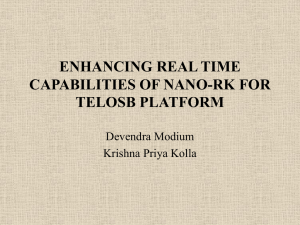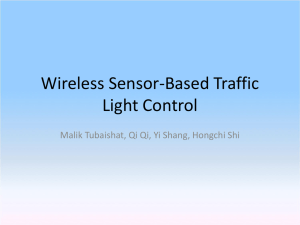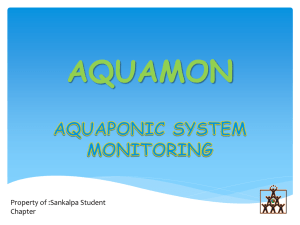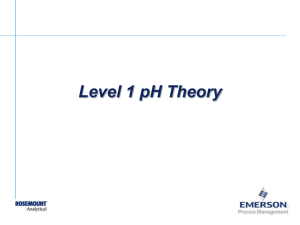Integration of a miniturised conductivity sensor into an
advertisement
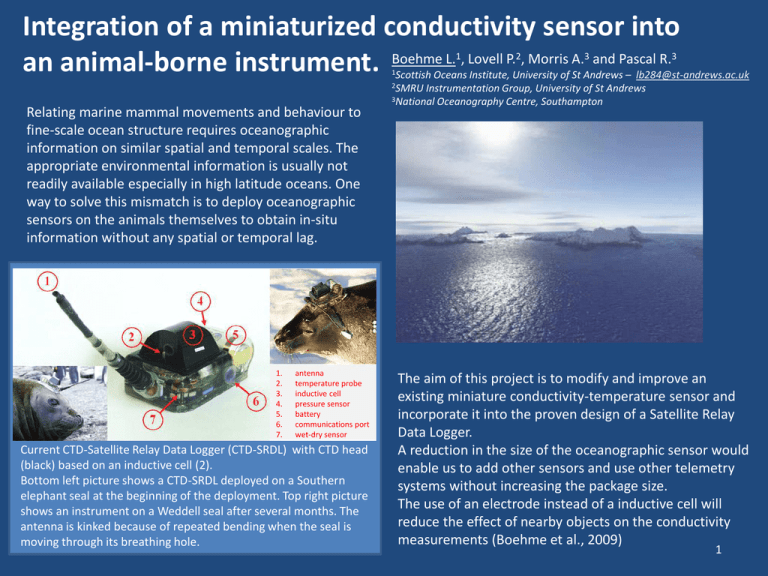
Integration of a miniaturized conductivity sensor into an animal-borne instrument. Boehme L. , Lovell P. , Morris A. and Pascal R. 1 2 3 3 1Scottish Oceans Institute, University of St Andrews – lb284@st-andrews.ac.uk Instrumentation Group, University of St Andrews 3National Oceanography Centre, Southampton 2SMRU Relating marine mammal movements and behaviour to fine-scale ocean structure requires oceanographic information on similar spatial and temporal scales. The appropriate environmental information is usually not readily available especially in high latitude oceans. One way to solve this mismatch is to deploy oceanographic sensors on the animals themselves to obtain in-situ information without any spatial or temporal lag. 1. 2. 3. 4. 5. 6. 7. antenna temperature probe inductive cell pressure sensor battery communications port wet-dry sensor Current CTD-Satellite Relay Data Logger (CTD-SRDL) with CTD head (black) based on an inductive cell (2). Bottom left picture shows a CTD-SRDL deployed on a Southern elephant seal at the beginning of the deployment. Top right picture shows an instrument on a Weddell seal after several months. The antenna is kinked because of repeated bending when the seal is moving through its breathing hole. The aim of this project is to modify and improve an existing miniature conductivity-temperature sensor and incorporate it into the proven design of a Satellite Relay Data Logger. A reduction in the size of the oceanographic sensor would enable us to add other sensors and use other telemetry systems without increasing the package size. The use of an electrode instead of a inductive cell will reduce the effect of nearby objects on the conductivity measurements (Boehme et al., 2009) 1 Integration of a miniaturized conductivity sensor into an animal-borne instrument. In this study, we modified an existing miniature conductivity-temperature sensor of about 10x10mm (Huang et al., 2011) nad designed a new control board to deliver temperature and conductivity measurements via an I2C interface. Three miniature sensors (left) and one sensor with new control board (right) ready to be interfaced with a SRDL. Current animal-borne instruments using an inductive cell to measure the salinity of the surrounding water need a ‘rigid’ attachment, which is normally only possible when the animal can be restrained during the attachment procedure limiting their use to seals and small cetaceans. This new sensor is not influenced by the attachment method and would therefore be able to provide accurate measurements while rotating around a barb attachment as is used to tag large cetaceans. References The sensor is currently undergoing lab and field tests to determine the accuracy and effect of bio-fouling on the sensor’s reliability. Boehme, L., P. Lovell, M. Biuw, F. Roquet, J. Nicholson, S. E. Thorpe, M. P. Meredith, and M. Fedak (2009), Technical Note: Animal-borne CTDSatellite Relay Data Loggers for real-time oceanographic data collection, Ocean Science, 5(4), 685-695. This methodology provides for ecosystem studies of a range of marine animals (e.g. large cetaceans, fish, birds) that are not currently feasible. Huang, X., R. W. Pascal, K. Chamberlain, C. J. Banks, M. Mowlem, and H. Morgan (2011), A Miniature, High Precision Conductivity and Temperature Sensor System for Ocean Monitoring, Ieee Sens J, 11(12), 3246-3252. 2 Design studies for new animal-borne instruments using the miniature sensor. GPS/Iridium-CTD-SRDL (left) and cetacean SRDL for barb attachment (left)



